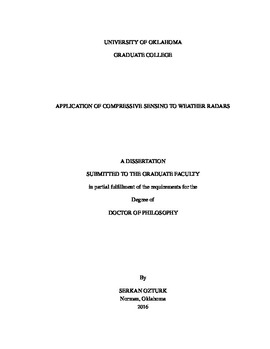| dc.contributor.advisor | Yu, Tain-You | |
| dc.contributor.advisor | Ding, Lei | |
| dc.contributor.author | Ozturk, Serkan | |
| dc.date.accessioned | 2016-09-30T18:01:23Z | |
| dc.date.available | 2016-09-30T18:01:23Z | |
| dc.date.issued | 2016-12-16 | |
| dc.identifier.uri | https://hdl.handle.net/11244/45393 | |
| dc.description.abstract | The capability and importance of weather radar are proven for hazardous weathers detection, monitoring, and prediction in both research and operations. Continuous efforts have been made in improving radar performance in terms of spatial and temporal resolutions, data quality, new capabilities, etc. On the other hand, compressive sensing (CS) theory has been developed for solving underdetermined problems using l1-norm minimization. It has been shown that CS is capable of reconstructing the sparse images from a limited number of measurements. In this work, CS is specifically applied to two weather radar problems of (1) refractivity retrieval using a network of radars, and (2) retrieving reflectivity and velocity from an imaging radar.
In the first study, CS is proposed to improve the refractivity retrieval since the performance of a conventional constraint least squares method can be degraded significantly by the measurement noise and the limited number of high-quality ground returns. The application of CS to refractivity retrieval is formulated using a linear model and subsequently the feasibility is demonstrated and verified using simulations. In the second study, the problem of digital beamforming (DBF) is posed as an inverse problem and formulated using a linear model for both reflectivity and velocity estimation for CS. The application of CS is investigated using both simulation and real data. In simulations, the performance of CS is quantified and compared to the traditional Fourier beamforming and high resolution Capon beamforming for various conditions. The feasibility of CS to weather observations is further demonstrated using the data collected by the Atmospheric Imaging Radar (AIR), developed at the Advanced Radar Research Center (ARRC) of the University of Oklahoma, on 15 April 2012. | en_US |
| dc.language | en_US | en_US |
| dc.subject | Compressive sensing, Refractivity retrieval, Phased array radars, Imaging radars, Inverse problems | en_US |
| dc.subject | Reflectivity and Velocity reconstruction | en_US |
| dc.title | Application of Compressive Sensing to Weather Radars | en_US |
| dc.contributor.committeeMember | Palmer, Robert | |
| dc.contributor.committeeMember | Cheong, Boon Leng | |
| dc.contributor.committeeMember | Xue, Ming | |
| dc.date.manuscript | 2016-09-30 | |
| dc.thesis.degree | Ph.D. | en_US |
| ou.group | College of Engineering::School of Electrical and Computer Engineering | en_US |
